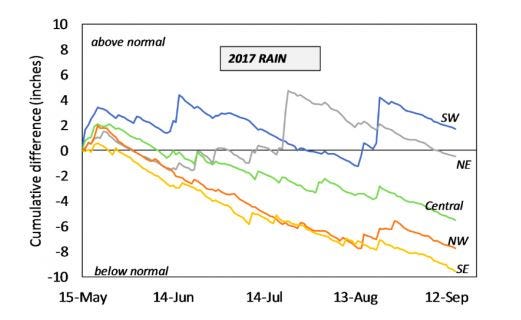
We now seem to have the ability to produce a record or near-record crop in less-than-ideal weather situations, thanks to recent advances in corn and soybean breeding, along with new technology.
Iowa’s average corn yield in 2017 was 202 bushels per acre, down 1 bushel from 2016. It was just the second time the state’s corn yields averaged more than 200 bushels per acre. Iowa soybeans averaged 56.5 bushels per acre in 2017, down from 60 bushels the previous year, according to USDA.
While these recent advances help, the yield was also due to temperatures and the subsoil moisture supply, says Mark Licht, Iowa State University Extension cropping systems agronomist. With a dry June and July in much of Iowa last summer, roots had to reach deep to find moisture. At the ISU Extension Crop Advantage meetings this winter, Licht and ISU colleague Sotirios Archontoulis provide the following explanation.
In some areas, June-July drought severe
Most of Iowa in 2017 was wet and cool during planting time (end of April to mid-May), warm and dry during vegetative growth (June to July), and cool and wet during reproductive development (August to September). In some locations, the June-July drought was severe, with precipitation deficits exceeding 8 inches. Despite this drought, yields were high and above the long-term trend for a third straight year.
In-season rainfall is not the only source of water for crops in Iowa, the ISU agronomists point out. Stored soil water and shallow groundwater were significant contributors to total water uptake. For this reason, crops survived the June-July drought. Field measurements revealed the depth to the water table was about 5 to 6 feet below the soil surface in mid-July (corn silking time), and crop roots had reached that depth. Deep roots and shallow water tables compensated for much of the precipitation deficit.
Dry June favorable in Iowa
Below-normal June rainfall is favorable in Iowa for two reasons, says Archontoulis:
• rapid and unconstrained root growth (up to 1.3 inches per day)
• no additional nitrogen loss due to additional precipitation
In terms of corn grain yield equivalent, a computer model analysis by the agronomists suggests root access to shallow groundwater accounted for 1% to 46% of total grain yield. The contribution was lower in sites with sufficient rain and higher in sites with drought. In addition to water, the same analysis indicated the subsoil had more than enough nutrients for sustaining high crop yields.

RAINFALL: Cumulative difference between 2017 precipitation and 35-year average for five locations in Iowa. Grain yields ranged from 190 to 235 bushels per acre.

Cool temperatures helpful
Cool temperatures in August and September also helped boost yields, Licht says. The cool weather reduced transpiration rates, slowed crop development and extended the grain-filling period. Also, the growing season was extended by a later-than-normal first killing frost in fall. This resulted in higher- than-normal kernel weight in corn.
“Together, these factors contributed to surprisingly high corn yields in 2017,” Archontoulis says. “Quantifying temperature, precipitation and water table dynamics across the state has been an important part of moving the science of digital agriculture forward to enable better predictions of yield, and will greatly assist management decisions and the predictability of crop yields and nitrogen losses.”
Licht adds, “A combination of good early vegetative growth, root growth extending deeply to obtain soil moisture, and an extended grain filling period all attributed to greater-than-expected corn and soybean yields in 2017.”

GROWING DEGREE DAYS: Cumulative difference between 2017 cumulative GDD and 35-year average for five locations in Iowa. Grain yields ranged from 190 to 235 bushels per acre.
About the Author(s)
You May Also Like




